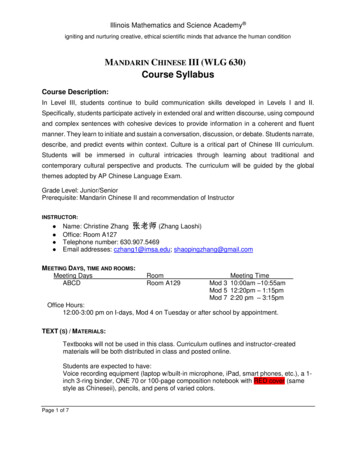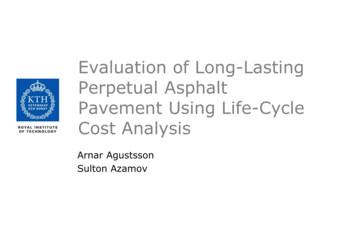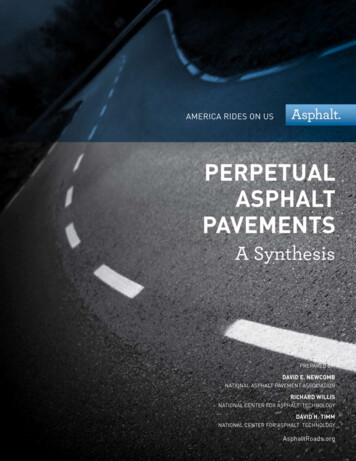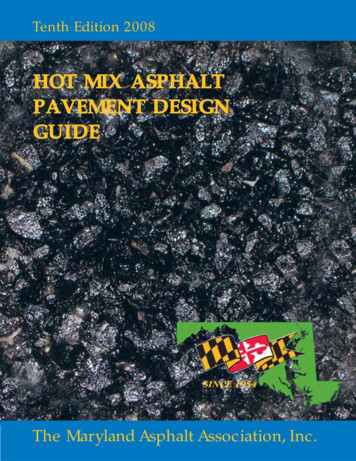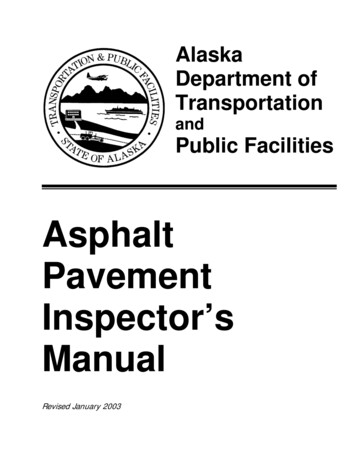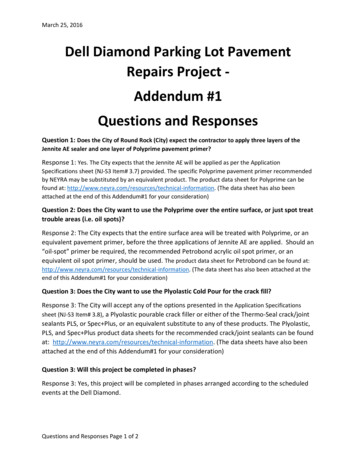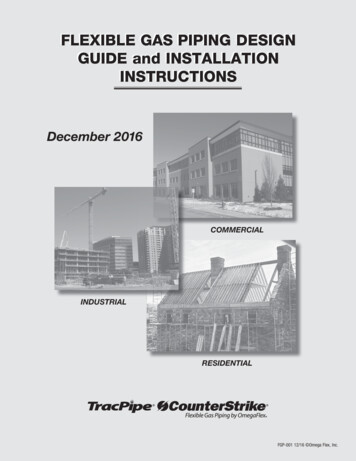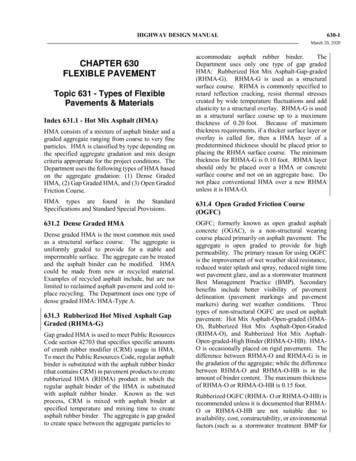
Transcription
HIGHWAY DESIGN MANUAL630-1March 20, 2020CHAPTER 630FLEXIBLE PAVEMENTTopic 631 - Types of FlexiblePavements & MaterialsIndex 631.1 - Hot Mix Asphalt (HMA)HMA consists of a mixture of asphalt binder and agraded aggregate ranging from coarse to very fineparticles. HMA is classified by type depending onthe specified aggregate gradation and mix designcriteria appropriate for the project conditions. TheDepartment uses the following types of HMA basedon the aggregate gradation: (1) Dense GradedHMA, (2) Gap Graded HMA, and (3) Open GradedFriction Course.accommodate asphalt rubber binder.TheDepartment uses only one type of gap gradedHMA: Rubberized Hot Mix Asphalt-Gap-graded(RHMA-G). RHMA-G is used as a structuralsurface course. RHMA is commonly specified toretard reflection cracking, resist thermal stressescreated by wide temperature fluctuations and addelasticity to a structural overlay. RHMA-G is usedas a structural surface course up to a maximumthickness of 0.20 foot. Because of maximumthickness requirements, if a thicker surface layer oroverlay is called for, then a HMA layer of apredetermined thickness should be placed prior toplacing the RHMA surface course. The minimumthickness for RHMA-G is 0.10 foot. RHMA layershould only be placed over a HMA or concretesurface course and not on an aggregate base. Donot place conventional HMA over a new RHMAunless it is HMA-O.HMA types are found in the StandardSpecifications and Standard Special Provisions.631.4 Open Graded Friction Course(OGFC)631.2 Dense Graded HMAOGFC; formerly known as open graded asphaltconcrete (OGAC), is a non-structural wearingcourse placed primarily on asphalt pavement. Theaggregate is open graded to provide for highpermeability. The primary reason for using OGFCis the improvement of wet weather skid resistance,reduced water splash and spray, reduced night timewet pavement glare, and as a stormwater treatmentBest Management Practice (BMP). Secondarybenefits include better visibility of pavementdelineation (pavement markings and pavementmarkers) during wet weather conditions. Threetypes of non-structural OGFC are used on asphaltpavement: Hot Mix Asphalt-Open-graded (HMAO), Rubberized Hot Mix Asphalt-Open-Graded(RHMA-O), and Rubberized Hot Mix AsphaltOpen-graded-High Binder (RHMA-O-HB). HMAO is occasionally placed on rigid pavements. Thedifference between RHMA-O and RHMA-G is inthe gradation of the aggregate; while the differencebetween RHMA-O and RHMA-O-HB is in theamount of binder content. The maximum thicknessof RHMA-O or RHMA-O-HB is 0.15 foot.Dense graded HMA is the most common mix usedas a structural surface course. The aggregate isuniformly graded to provide for a stable andimpermeable surface. The aggregate can be treatedand the asphalt binder can be modified. HMAcould be made from new or recycled material.Examples of recycled asphalt include, but are notlimited to reclaimed asphalt pavement and cold inplace recycling. The Department uses one type ofdense graded HMA: HMA-Type A.631.3 Rubberized Hot Mixed Asphalt GapGraded (RHMA-G)Gap graded HMA is used to meet Public ResourcesCode section 42703 that specifies specific amountsof crumb rubber modifier (CRM) usage in HMA.To meet the Public Resources Code, regular asphaltbinder is substituted with the asphalt rubber binder(that contains CRM) in pavement products to createrubberized HMA (RHMA) product in which theregular asphalt binder of the HMA is substitutedwith asphalt rubber binder. Known as the wetprocess, CRM is mixed with asphalt binder atspecified temperature and mixing time to createasphalt rubber binder. The aggregate is gap gradedto create space between the aggregate particles toRubberized OGFC (RHMA- O or RHMA-O-HB) isrecommended unless it is documented that RHMAO or RHMA-O-HB are not suitable due toavailability, cost, constructability, or environmentalfactors (such as a stormwater treatment BMP for
630-2HIGHWAY DESIGN MANUALMarch 20, 2020National Pollutant Discharge Elimination System(NPDES) compliance). RHMA-O and RHMA-OHB are not expected to provide a water qualitybenefit. The project engineer should balance thecompeting requirement of recycled crumb rubbergoals with those for stormwater treatment anddocument in the project report. Coordinate with thedistrict pavements engineer and NPDEScoordinator to determine if both goals are on targetfor compliance. It is undesirable to place RHMAO in areas that will not allow surface water to drain.As an example, a surface that is milled only on thetraveled way and not on the shoulder forms a“bathtub” section that can trap water beneath thesurface of the traveled way. To prevent this effect,HMA should be placed on the milled surface(traveled way only) and OGFC should be placedover the entire cross section of the road (traveledway and shoulders).For additional information and applicability ofOGFC in new construction and rehabilitationprojects refer to OGFC Guideline available on theDepartment Pavement website.Also, seeMaintenance Technical Advisory Guide (MTAG)for additional information and use of OGFC inpavement preservation. If OGFC is proposed as astormwater treatment BMP, see OGFC StormwaterTreatment BMP Guidance on the Design website.availability of several HMA production plantsthat have full time RHMA blending plants onsite. When the ambient temperatures forecasted atthe time of placement will be below 45 F. Where the roadway elevation is above3,000 feet. When the project has a Caltrans NPDES permitrequirement for treatment BMPs (onlyapplicable for RHMA-O or RHMA-O-HBexception).For additional information on and applicability ofRHMA in new construction and rehabilitationprojects refer to Asphalt Rubber Usage Guideavailable on the Pavement website.631.6 Other Types of Flexible PavementSurface CoursesThere are other types of flexible pavement surfacecourses such as cold mix, Resin Pavement, andSulphur Extended Hot Mix Asphalt. The othertypes of pavements are either used for maintenancetreatments or not currently used on State highways.For pavement preservation and other maintenancetreatments refer to the Caltrans MaintenanceManual and MTAG.631.5 Rubberized HMA (RHMA) Use631.7 Warm Mix Asphalt TechnologyCurrently, three RHMA products are used: gapgraded (RHMA-G), open-graded (RHMA-O), andopen-graded-high binder (RHMA-O-HB) mixes.HMA may be produced using the Warm MixAsphalt (WMA) technology. The Department hasa permissive specification which allows contractorsto use WMA technology as compaction aid. TheDepartment has an approved list of WMA additivestechnology and WMA water injection technology.Ambient and surface temperature requirements forboth the WMA additives and WMA water injectiontechnologies are specified in the standardspecifications. The designer with reasonableassurance of these ambient and surfacetemperatures should specify WMA additivestechnology to avoid unnecessary conflicts anddelays with marginal temperatures conditions onactual paving day.The minimum thickness for RHMA (any type)should be 0.10 foot for rehabilitation and pavementpreservation projects. These RHMA products areconsidered to be the asphalt pavement surfacecourses of choice for a project unless it isdocumented that RHMA is not suitable due toavailability, cost, constructability or environmentalfactors (Treatment BMP). The following describessituations where RHMA should not be used: When RHMA project quantities are 1,000 tonsor less or staged construction operations requireless than 1,000 tons of RHMA per stage. Thisis due to the higher costs associated withmobilizing an asphalt rubber blending plant.The 1,000-ton minimum does not apply in LosAngeles/Inland Empire areas due to theWhere ambient and surface temperatures are notissues, WMA may still be specified if otherconditions such as long haul and coastal and windyconditions justify its use as compaction aid.
HIGHWAY DESIGN MANUAL630-3March 20, 2020RHMA-G may be placed when ambient air orsurface temperature is between 45 F and 49.9 Fprovided that WMA additives technology isspecified.WMA does not change the design parametersrepresentative of HMA. Therefore, all designmethods discussed in this chapter using hot mixasphalt are also applicable to warm mix asphaltproducts.631.8 Pavement InterlayersPavement interlayers are used with asphaltpavement as a means to retard reflective cracksfrom existing pavement into the new flexible layer,prevent water infiltration deeper into the pavementstructure, and enhance pavement structuralstrength. Two types of pavement interlayers are: Rubberized Pavement Interlayers (RPI); alsoknown as Rubberized Stress AbsorbingMembrane Interlayer (SAMI-R); which issimply a rubberized chip seal. Geosynthetic Pavement Interlayer (GPI). GPIconsists mainly of asphalt-saturated geotextile(also called fabric), but other geosyntheticplanar products such as paving grids and pavinggeocomposites (grid attached to geotextile) arealso used. Refer to Standard Specifications forthe various GPI types.Sound engineering judgment is required whenconsidering the use of a pavement interlayers. Thefollowing must be considered: Consideration should be given to areas that mayprohibit surface water from draining out thesides of the overlay, thus forming a “bathtub”section. Since pavement interlayer can act as a moisturebarrier, it should be used with caution in hotenvironments where it could preventunderlying moisture from evaporating. When placed on an existing pavement,preparation is required to prevent excess stresson the membrane. This includes sealing crackswider than ¼ inch and repairing potholes andlocalized failures.A pavement interlayer may be placed betweenlayers of new flexible pavement, such as on anasphalt leveling course, or on the surface of anexisting flexible pavement. A GPI should not beplaced directly on coarse surfaces such as a chipseal, OGFC, areas of numerous rough patches, oron a pavement that has been cold planed. As anexample, coarse surfaces may penetrate the pavingfabric and the paving asphalt binder used to saturatethe fabric may collect in the voids or valleys leavingareas of the fabric dry. For the GPI to be effectivein these areas, use a layer of HMA prior to theplacement of the GPI.GPI is ineffective in the following applications: For providing added structural strength whenplaced in combination with new flexiblepavement. In the reduction of thermal cracking of the newflexible pavement overlay.When using a GPI, care must be taken to specify aproduct that can withstand temperatures of theasphalt placed above it, particularly for RHMA.Detailed information for selecting appropriate typeof pavement interlayer to use can be found in theMTAG on the Department Pavement website.Topic 632 – Asphalt Binder632.1 Binder ClassificationAsphalt binders are most commonly characterizedby their physical properties which directly affectasphalt pavement field performance. Althoughasphalt binder viscosity grading is still common,new binder tests and specifications have beendeveloped to more accurately characterizetemperature extremes which pavements in the fieldare expected to withstand. These tests andspecifications are particularly designed to addressthree specific asphalt pavement distress types:permanent deformation (rutting), fatigue cracking,and low temperature cracking.In the past, unmodified asphalt binders wereclassified using viscosity grading based on theAged Residue (AR) System and PerformanceBased Asphalt (PBA) binder system. BeginningJanuary 1, 2006, the Department switched to thenationally recognized Performance Grade (PG)System for conventional binders.EffectiveJanuary 1, 2013, the Department has graded
630-4HIGHWAY DESIGN MANUALMarch 20, 2020modified binders as Performance Graded Modified(PG-M) binder. Binder modification is achievedusing either crumb rubber, polymers, or both.Performance grading is based on the concept thatasphalt binder properties should be related to theconditions under which the binder is used. PGasphalt binders are selected to meet expectedclimatic conditions as well as traffic speed andvolume. Therefore, the PG system uses a commonset of tests to measure physical properties of thebinder that can be directly related to fieldperformance of the pavement at its servicetemperatures. For example, a binder identified asPG 64-10 (64 minus 10) must meet certainperformance criteria at an average seven-daymaximum pavement temperature of 64 C and alsoat a minimum pavement temperature of –10 C.Although modified asphalt binder is moreexpensive than unmodified binder, it can provideimproved performance and durability for sensitiveclimate conditions. While unmodified binder isadequate for most applications, improvedresistance to rutting, thermal cracking, fatiguedamage, stripping, and temperature susceptibilityhave led polymer modified binders to be substitutedfor unmodified asphalt binders in many paving andmaintenance applications.632.2 Binder SelectionTable 632.1 provides the binder grade that is to beused for each climatic region for generalapplication. For HMA, values are given for typicaland special conditions.For a few selectapplications such as dikes and tack coats, PG binderrequirements are found in the applicable StandardSpecifications or Standard Special Provisions.For locations of each pavement climate region seeTopic 615.Binder selection based on climate region is crucialfor improving the pavement resistance totemperature extremes during its service life; whichin turn is critical in controlling thermal cracking andother distress types affected by temperature.Special conditions in Table 632.1 are defined asthose roadways or portion of roadways that needadditional attention due to conditions such as: Heavy truck/bus traffic (over 10 millionESALs for 20 years). Truck/bus stopping areas (parking area, restarea, loading area, etc.). Truck/bus stop-and-go areas (intersections,metered ramps, ramps to and from TruckScales, etc.). Truck/bus climbing and descending lanes.The final deci
20.03.2020 · Index 631.1 - Hot Mix Asphalt (HMA) HMA consists of a mixture of asphalt binder and a graded aggregate ranging from coarse to very fine particles. HMA is classified by type depending on the specified aggregate gradation and mix design criteria appropriate for the project conditions. The Department uses the following types of HMA based on the aggregate gradation: (1) Dense Graded


